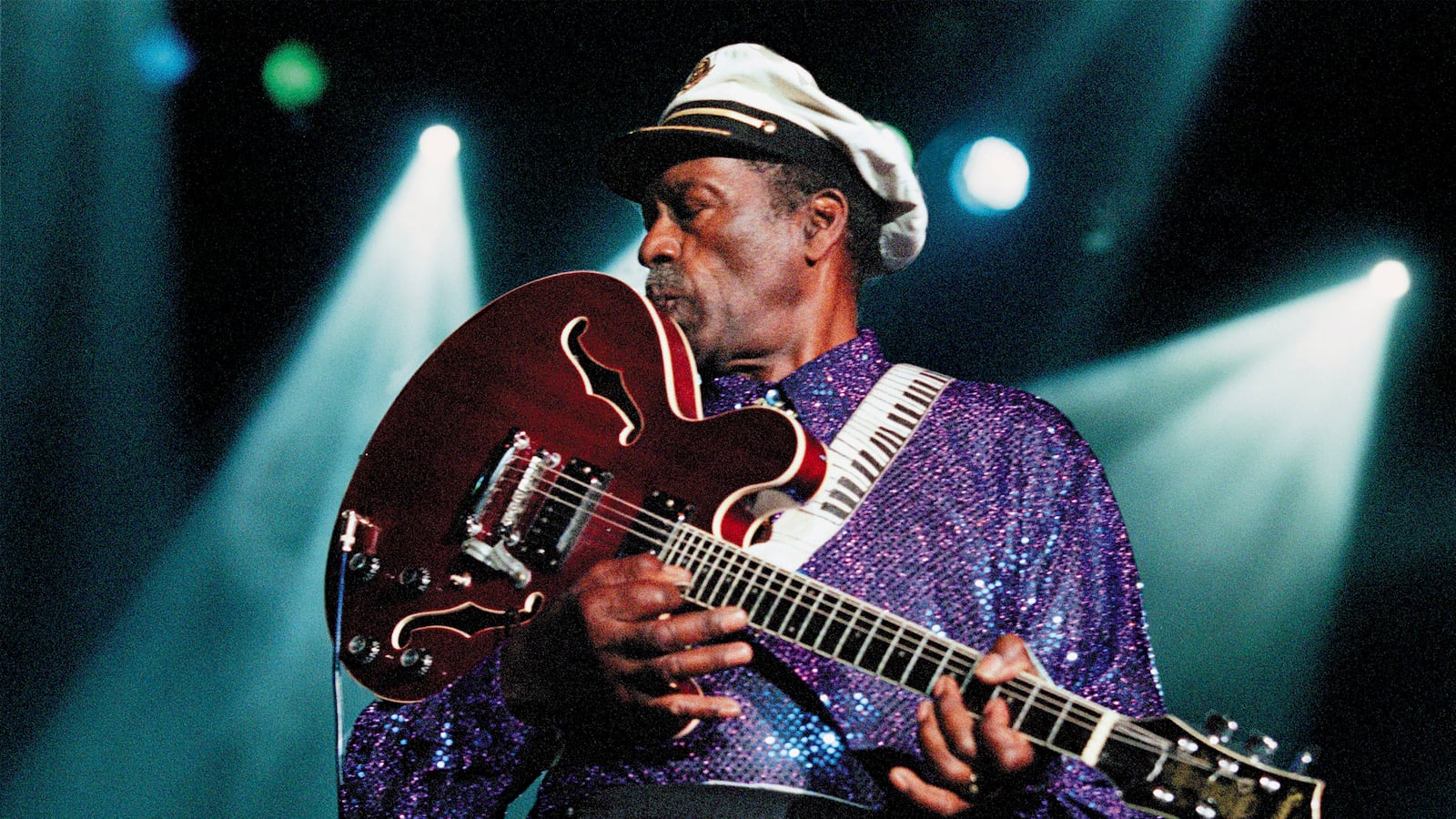At the beginning of the ’50s, each of the various musics now thriving in America was connected in some way with the African American source and with the freedom impulse. Bop had produced self-conscious artists who refused to bow to conventional assumptions of what was entertaining. In freeing their music from the standard assumptions of show business, the boppers had taken an enormous risk—and their audience, at least as white as it was black, understood that and supported the implicit goal of liberation.
At this time early in the decade, the electric blues of Chicago had an almost exclusively black audience, but the music stood for a black autonomy that would be instantly grasped by the white acolytes who would locate it a few years later. R & B’s celebration of good times delivered the same message of dancing sensuality as its predecessors ragtime and early jazz. The blues were implicit in much of postwar country music, so it was no great stretch for country to fuse with R & B to form rockabilly. And folk music formally presented a progressive message of peaceful racial coexistence that was merely a verbal manifestation of the vision articulated by those fusing racial streams that in the new decade would give the world rock ’n’ roll. The stage was set for a remarkable transition.
Along with prosperity and the shiny-new, the ’50s brought other changes that would have long ripple effects. The great migration to the North through World War II had given black people at least some clout as they began to vote Democratic. In 1954, the Supreme Court handed down Brown v. Board of Education of Topeka, and the legal ground rules changed, although any realist knew that segregation wasn’t going to end quickly. Tensions escalated in August 1955 after the body of fourteen-year-old Emmett Till, a black boy from Chicago visiting relatives in Money, Mississippi, was pulled from the Tallahatchie River, one eye gouged out and a seventy-pound cotton gin mill fan around his neck.
His body was returned to Chicago, where his mother insisted that the public funeral service include an open casket, inspiring a wave of revulsion at the mutilations and renewed outcries about the state of justice in Mississippi. At trial, the state’s press and legal system closed ranks behind white supremacy, and the defendants were acquitted. Protected by the rule of double jeopardy, they smirked as they admitted their guilt to a journalist a few months later.
Black people began to move. Actually, Rosa Parks refused to move, and kept her seat on a Montgomery, Alabama bus. On December 1, 1955, she was sitting in a middle row when white people boarded, so that she was supposed to move back, or stand. Ms. Parks was the secretary of the local NAACP branch and had trained in nonviolent civil disobedience at Highlander Folk School, and she wasn’t putting up with any more bullshit. She remained seated and was arrested.
The president of the Montgomery NAACP, Pullman porter E. D. Nixon, saw an opportunity. He chose a charismatic, newly arrived young local minister, Martin Luther King Jr., to head their efforts, and together they began a boycott of public transit in Montgomery. For 381 days, no black person in Montgomery with a shred of self-esteem rode the bus. Late in 1956, a federal ruling, Browder v. Gayle, declared segregated buses unconstitutional. Earlier that year, there were riots at the University of Alabama protesting the presence of a black student named Autherine Lucy, and in the next few months, five deep-South states adopted pro-segregation measures.
The 1950s, observed C. Vann Woodward, resembled the era of Reconstruction in many ways. Both followed wars; people were tired of idealism and self-sacrifice and were determined to enjoy a self- indulgent materialism. A popular general was president, “celebrated for qualities other than moral enthusiasm.” Of course, the South was much stronger than in the 1870s, not devastated by a war and extremely well represented in Congress. So when North Carolina senator Sam Ervin drafted a “Southern Manifesto” in March 1956 that promised to maintain Jim Crow segregation, getting support from 101 of the 128 members of Congress who represented the eleven original Confederate states, one might have surmised his cause would prevail.
When Governor Orville Faubus used the Arkansas National Guard to block the desegregation of Little Rock Central High School in 1957, he forced the previously silent Eisenhower to assert federal authority. Ike sent in the army, which would stay at Central the entire school year. Faubus would respond by closing Little Rock’s high schools for the school year 1958–59, making him a hero to many Arkansans. Virginia closed schools rather than desegregate, and desegregation ground to a halt, with the bulk of the South convincing itself that the problem was all a result of outside agitators.
Black-white relations had signifiers other than the overt events of the civil rights movement. In its own way, music would muddle racial barriers perhaps even more effectively than campaigns did, and the authorities were not unaware of it. In 1955, the Juvenile Delinquency and Crime Commission of Houston, Texas, asked local radio stations to ban twenty songs, a list that included “Work With Me Annie” (Hank Ballard and the Midnighters), and “I Got a Woman” (Ray Charles), black R & B that was also stimulating an emerging rock ’n’ roll that would seem honest and fresh, not least because some of the first great rock songs were written by the artists who performed them. Even more importantly, rock—as jazz and ragtime before it—excited the body and made kids want to dance, part of a long line of cultural evolution that had started in Africa, emerged in the black church, and now rang triumphant.
Rock ’n’ roll, in fact, would be African American culture’s ultimately most powerful gift to the white children of the ’50s, ’60s, and after, the third—after ragtime and jazz—of the cultural fusions that had spun off black creativity. Each of those gifts took the main- stream culture toward a greater tolerance and a was powerful stuff indeed, and these influences have not stopped in their effects.
Bill Haley had kicked rock off with “Rock Around the Clock,” but Elvis Presley made it an international phenomenon. Just as Haley had started out cowboy but listened to the blues, Sam Phillips of Memphis found in Elvis his own white kid who could sing like a black man. Sam mentioned him to another young man around the studio, a guitarist named Scotty Moore, who played boogie in the honky-tonks around Memphis with both jazz (Tal Farlow and Barney Kessel) and country (Merle Travis, Chet Atkins) influences.
Wearing white shoes and a pink suit, Elvis stopped by Scotty’s house to talk about songs to record, and the two names Scotty recalled from the chat were Marty Robbins and Billy Eckstine. When they got to the studio on July 5, 1954, things didn’t go so well, perhaps because Elvis was nervous. “He tried not to show it,” said Phillips, “but he felt so inferior. He reminded me of a black man in that way, his insecurity was so markedly like that of a black person.”
Which perhaps rang true when, having wasted some time, they took a stab at Arthur Crudup’s “That’s All Right,” and pinned it perfectly to the grooves. Blues with a country beat, the fusion of black and white, had found its personification in Elvis. A lifelong member of the Pentecostal First Assembly of God who’d sung gospel from the age of two, he mixed church music with listening to Roy Acuff and Eddy Arnold at the Opry, Bill Broonzy, and Arthur “Big Boy” Crudup. Locally, he followed B. B. King, the Memphis blues guitar master, and spent considerable time with him.
Elvis yearned to live a larger life than that of a resident of the Lauderdale Courts public housing facility who drove a truck for the Crown Electric Company, and he’d get all the success that anybody could ever dream of and more as he recorded fourteen consecutive million sellers and became the King of Rock ’n’ Roll. It was a success so overwhelming that he’d spend the rest of his life mostly trying to hold on to his sanity. Meantime, he’d be managed by “Colonel” Tom Parker, who’d make sure Elvis would never grow, but would continue filling Parker’s pockets until the day he died, and long after.
In the end, guitars were and would remain the heart of rock ’n’ roll, and the first important rock guitarist was named Chuck Berry. In late April or early May 1955, Chuck approached Muddy Waters about recording, and Muddy sent him to Leonard Chess. On May 21, 1955, Berry, Johnnie Johnson on piano, Ebby Hardy on drums, and Chess house producer Willie Dixon on bass recorded thirty-five takes of a country-western song mixing hot rods and romance called “Ida Red,” which owed something to a Charlie Poole and the North Carolina Ramblers tune called “Shooting Creek,” but whose best-known version came from Bob Wills and the Texas Playboys.
As Johnson recalled it, Leonard didn’t like the title and, after noticing a bottle of makeup, suggested it be called “Maybellene.” Kingpin disc jockey Alan Freed heard it and flipped at the combination of country harmonies and blues rhythms, and after getting a piece of the royalties (along with Russ Fratto, Chess’s landlord and part-owner of Midwest Record Pressing), helped make it, by July 1955, a #1 R & B song and a #5 pop song.
That November, The Ed Sullivan Show, America’s national stage, would present fifteen minutes of rock with Chuck, Bo Diddley, and LaVern Baker. The next day, RCA would announce that they’d signed Elvis, and by February 1956 he was on the Dorsey Brothers’ national TV show. In May, Chuck’s insouciant wink at the classical world, “Roll Over Beethoven,” charged up the charts. Presley’s “Heartbreak Hotel” had been #1 for three weeks and would be the #1 record of 1956, reaching #1 on the Country-Western charts and #5 on the R & B charts, with two other Elvis songs, three Haley songs, two Little Richard songs, and two Fats Domino songs at the top.
Black and white were now mixing sufficiently to make a Klan member weep. Presley, the white Negro, was singing black Otis Blackwell’s “Don’t Be Cruel,” the B side of “(You Ain’t Nothing But a) Hound Dog,” written by two white guys with an enormous affinity for black culture named Mike Stoller and Jerry Lieber. First sung by Big Mama Thornton, “Hound Dog” went to #1 on the pop, rock, and R & B charts, which made Elvis the first white guy to top the R & B charts since Johnny Ray, five years before. Contrarily, Chuck Berry’s driver’s license identified him as Native American, and he used underexposed PR photos to suggest he was white, or perhaps Hawaiian.
By the mid-’50s, the singles market was the province of the young, with albums, first introduced in 1948 by Columbia, now directed at adults; South Pacific had been the best-selling album from 1949 to 1951.
Early rock ’n’ roll’s assault on the charts lasted only long enough to establish what Greil Marcus called “the crucial image of rock ’n’ roll: the sexy, half-crazed fool standing on stage singing his guts out.” Drafted, Elvis would enter the army in March 1958. On the heels of his big (and only) hit, “Blue Suede Shoes,” Carl Perkins suffered a devastating car accident in March 1956 that would interrupt his career. Little Richard left rock ’n’ roll for the Lord on October 12, 1957.
When the press learned in May 1958 of Jerry Lee Lewis’s marriage to Myra Gale Brown, his thirteen-year-old cousin-once-removed, his future dimmed. Buddy Holly, Richie Valens, and J. P. “The Big Bopper” Richardson died in a plane crash in Clear Lake, Iowa, on February 3, 1959. And in December 1959, Chuck Berry was arrested under the Mann Act for consorting with Janice Escalante, a fourteen- year-old girl from Juarez, Mexico, whom he’d brought to his club near St. Louis to work as a hatcheck girl. A patently bigoted judge full of inflammatory questions ensured a guilty charge, and after two trials, Chuck spent a year and a half in prison. Rock seemed to have been a brilliant but very brief light in the sky.
From On Highway 61: Music, Race, and the Evolution of Cultural Freedom by Dennis McNally. Copyright 2014 by Dennis McNally. Published by Counterpoint Press. Reprinted with permission.






